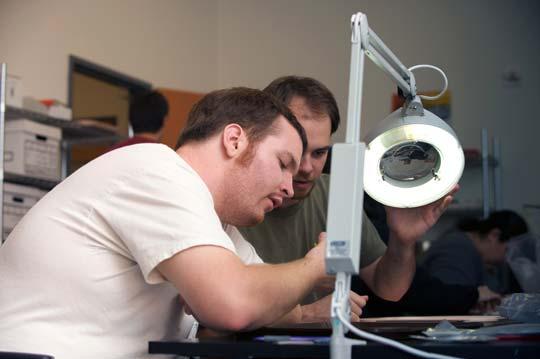Putting it All Together at the Archaeology Lab
Humboldt’s Archaeology Lab Gives Students a Chance to Uncover History, Piece by Piece
Looking at the pile of unlabeled, broken glass bottles, most people would see recycling. But not Leslie Perkins, an Anthropology major immersed in work at the department’s Archaeology Laboratory. “It tells a story about what people were doing back near the turn of the 20th century,” she says.
The bottles were taken from an archaeological dig site, known within the Department of Anthropology as the Falk site. Students, like Perkins, are collecting artifacts and bringing them back to the lab for analysis. To the untrained eye, it is nearly impossible to tell when the bottles were made or what they were used for. But students in the lab can use indicators, like the glass thickness, color and manufacturing techniques, to uncover those details.
Being able to differentiate a medicine bottle from a prohibition-era whiskey bottle is a great skill for archaeologists to have, but the benefit for students working in the lab goes even further. “With some of the bottle glass from Falk, the person who analyzes it can potentially get publication credit, too,” Perkins says. “You can really get into your work.”
Students can use the lab to piece together animal skeletons or identify and catalog southwestern pottery shards. Equipment in the lab can magnify an artifact up to 300 times—powerful enough to identify animal proteins on ancient cutting tools.
But a person with an interest in archaeology doesn’t need a specific project in mind to dig into lab work. Adam Forbis wasn’t sure what kind of lab work he would do for Anthropology Professor Marisol Cortes-Rincon, director of the Archaeology Lab. However, after seeing him doodle on his notes for her class, she asked Forbis to try his hand at technical illustrations. Now, his detailed depictions are adding to the department’s growing database of research.
“It doesn’t matter if a student is interested in California, historic eras, prehistoric eras, Central America, or lithics,” Cortes-Rincon says. “We have a little bit of everything.” And she isn’t opposed to creating new collections if it will help students sharpen their archaeological skills.
“Sometimes in the Maya Region objects will have the same design, but not the same form,” Cortes, Rincon says. To prepare her students for fieldwork, she purchased dinner plates with the same design but of various sizes. In the lab, her students had the opportunity to smash the plates to first see how objects tend to break. Later in the lab, the pieces were mixed up and students were asked to put them back together in order to get hands-on training in distinguishing shards of artifacts with similar patterns but different shapes and sizes.
“The hardest part of archaeology is the lab work,” Perkins says. “And I get to brag about it.”

